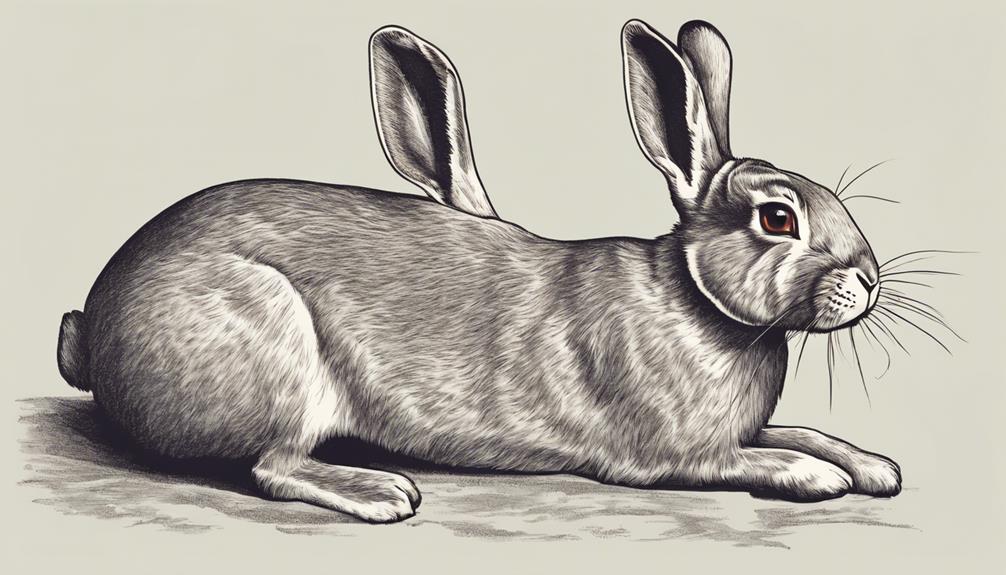When your rabbit thumps its hind legs repeatedly, it might be trying to communicate something important to you. Understanding these subtle cues can greatly improve your relationship with your fluffy companion.
By honing in on their nonverbal language, you can decipher their feelings and needs more effectively.
Stay tuned to discover five valuable tips that will help you navigate the intricate world of rabbit communication and deepen your bond with your furry friend.
Contents
Key Takeaways
- Pay attention to your rabbit's ear movements to understand its emotions.
- Observe the position of your rabbit's tail to gauge its feelings.
- Listen to your rabbit's vocal cues for insight into its emotional needs.
- Note your rabbit's facial expressions to interpret its mood accurately.
Bunny Body Language Basics

When decoding your rabbit's nonverbal communication, understanding bunny body language basics is essential for interpreting their emotions accurately. A rabbit's body language, including their ears, tail, and overall posture, can provide valuable insights into how they're feeling.
For instance, if your rabbit has their ears laid back, it might indicate fear or stress, whereas ears perked up suggest curiosity. Observing their tail movements is also important; a raised tail could mean excitement, while a lowered tail might signal trouble or fear. Additionally, paying attention to vocal cues like purring or screeching can further help you understand your rabbit's emotions.
Interpreting Ear Movements
Interpreting the subtle movements of your rabbit's ears provides valuable insights into their emotions and communication signals. Rabbit ears offer a window into your furry friend's inner world, helping you understand how they feel without uttering a single word.
When your rabbit tilts their ears forward, it's a sign of curiosity and interest in their surroundings, showing that they're engaged and alert. Conversely, a sideways ear stance with ears up or back may indicate fear or apprehension, suggesting that your rabbit is feeling uneasy.
If you notice your rabbit holding their ears up or slightly back, it could be a sign of agitation, potentially signaling that they're irritated or annoyed. Additionally, an ear wobble in rabbits serves as a polite way of expressing 'No thank you' or discomfort, emphasizing the importance of paying attention to these subtle yet significant ear movements in decoding your rabbit's nonverbal communication cues.
Decoding Tail Signals

Your rabbit's tail movements offer a glimpse into their emotional world, conveying essential messages about their current state of mind. Understanding your rabbit's tail signals can help you better interpret their feelings and respond appropriately.
Here are some key points to ponder:
- Raised Tail: A raised tail in a rabbit typically indicates excitement or happiness. It's a positive sign that your rabbit is feeling good and content.
- Lowered Tail: On the other hand, a lowered tail can signal trouble or fear in rabbits. Ponder this gesture and investigate further if your rabbit appears distressed.
- Thumping: Thumping of the rear legs on the ground by a rabbit is a clear sign of trying to communicate alarm or stress. This behavior is often a cry for attention or a warning sign that something is amiss.
- Communication Tool: Like cats, a rabbit's tail serves as a communication tool conveying important messages. Observing your rabbit's tail movements can provide insights into their emotional state and current feelings.
Understanding Vocal Cues
Understanding rabbit vocal cues provides valuable insights into their emotional well-being and communication needs.
Grunting may signal that your rabbit is feeling angry, threatened, or stressed, indicating a need for reassurance or a change in their environment.
On the other hand, honking is a soft noise rabbits make during courtship or when they're excited, showing that they're feeling positive emotions.
Rabbit screaming is a distressing sound that indicates extreme terror or pain, requiring immediate attention and care.
Tooth clicking in rabbits is a comforting sound similar to a cat's purr, demonstrating contentment and happiness.
By paying attention to these vocal cues, you can better comprehend your rabbit's emotional state and address their needs effectively.
This deeper comprehension of your rabbit's communication can strengthen your bond and make their well-being a priority.
Reading Facial Expressions

Shifting from decoding vocal cues to reading facial expressions in rabbits reveals a whole new dimension of understanding their emotional states and communication patterns. When observing your rabbit's face, pay attention to these key points:
- Raised eyebrows: Indicates surprise or alertness in rabbits.
- Squinting eyes: Suggests contentment or relaxation in rabbits.
- Widened eyes with tense body language: Signals fear or stress in rabbits.
- Relaxed jaw and slightly visible teeth: Indicates a comfortable and content rabbit.
Frequently Asked Questions
What Are 4 Important Things to Keep in Mind When Handling or Carrying a Rabbit?
When handling a rabbit, remember to maintain a secure grip, approach gently, keep a calm demeanor, and respect boundaries. These actions help create a safe environment for your rabbit, promoting trust and minimizing fear.
How Do You Read a Rabbit's Body Language?
When observing a rabbit's body language, pay attention to ear position, tail movements, body posture, eye contact, grooming behavior, and vocalizations. These cues provide valuable insights into your rabbit's feelings and intentions.
How Do You Communicate With Rabbits?
In your conversations with rabbits, focus on bonding exercises, treat training, playtime activities, grooming techniques, understanding emotions, and creating a safe environment. These elements enhance communication, fostering a meaningful connection and mutual understanding.
What Tricks Can I Teach My Bunny?
To teach your bunny tricks, start with simple commands like coming when called or target training. Use treats and praise for motivation. Consistent, short training sessions throughout the day will help reinforce learning and strengthen your bond.
Conclusion
As you explore the fascinating world of decoding your rabbit's nonverbal communication, you'll uncover a treasure trove of insights into your furry friend's emotions and needs.
By observing their body language, from ear twitches to tail wiggles, you'll be able to deepen your bond and create a harmonious relationship with your rabbit.
So, pay attention, tune in to their cues, and watch as your understanding of your rabbit blossoms into a beautiful connection unlike any other.






